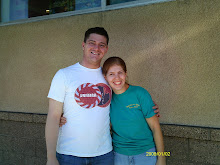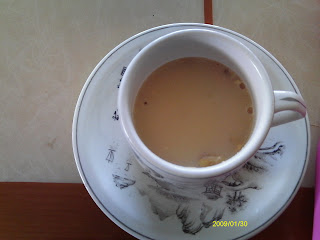This morning, my school's director, David, and I had a chance to be a part of the process of making kimchi and at the same time help out a local farming community whose focus is the care of the elderly and handicapped. In sum, 13 "patients" and two administrators live on the premises, which takes up a good three to four acres of hilly farmland tucked away in the foothills of Chungju. I was at once amazed by the humility of the conditions and a love for the people that I met. I had a chance to meet the woman who is the director of the facility, Pastor Kim, and her assistant. Pastor Kim seems to have a genuine heart for these people; in our transalted conversation, she mentioned those whose lives had been changed by her love intervention. I witnessed first-hand how she cared for them: by making their lunch, by directing their decisions, and by stirring cups of a warm, creamy drink at the end a cold, crisp work-day. I witnessed, too, the effort of everyone together working as a team to make the kimchi. It wasn't easy, by far, but it was a very good day.
As David tells me, the process of making kimchi is an ancient method for preserving Korea's nappa cabbage. I saw first-hand today how important a process like that can be: Just one acre of land (which is, I assume, all that the facility needed to grow its crop) was enough to yeild two flatbed truckloads of cabbage heads--and by the time we left at 3:40, there was at least one more truckload to harvest. The heads measured anywhere from a seven-inch diameter to a fourteen-inch, with a height of ten to twelve inches each. That's almost the size of a medium pizza! Needless to say, that's A LOT of cabbage! You can only eat so much of it; and it's not a vegetable that keeps well, like sweet potatoes. So what do you do with it? When you're in Korea, you do as the Koreans: you make kimchi.
The first step in kimchi-making (aside from the harvest itself) is to peel off the bad layers of cabbage leaf, then cut each head in half lengthwise, like a hotdog bun. The second is to soak it in hot salt water for a day and then to mix seasonings (like red pepper flakes) and other ingredients with it. The final stage of kimchi preparation (in the traditional method) is to scoop the mixture into ceramic vats buried in the ground, there to sit and ferment for up to a year. The more it ferments, I'm told, the better it is for your health because of the bacteria in it, like eating yogurt cultures or cheese.
I was only able to participate in the first stage, chopping each head in half. I tried later to help with soaking the heads in salt water, but was asked instead to "play with [the] dog" because the salt would ruin my clothes. I get the vague impression that kimchi-making is a distinctly Korean art and that foreigners ought not to mess with such a "good thing." Either that or I was caught being a girl again, not allowed to do something because it wasn't expressly safe! What little I was able to, however, felt oddly rewarding. "This is better than sitting in front of the computer all day," I said to myself as I sat on a plastic stool, square butcher-knife in one hand and half a cabbage in the other. Just as Ecclesiastes admonishes us, it was the simple pleasure of enjoying the work of your hands.
After my stint as a kimchi chef, we adjourned to the kitchen (also labeled "restaurant" on the sign in English) where David and I lunched on the kim bap and mandu that we had brought with us. David's justification for bringing our own lunch was due to my intollerance of spicy foods; he said the local community might not have anything too mild for me to try. At their insistance, we stayed to lunch with them also: They served us fish soup, rice, and a plethera of spicy vegetables and other "fixin's" to mix in with it. I was able to try lotus-flower root (that I enjoyed) and a Japanese plum that didn't set well with my taste buds. The other things, edible leaves and a dish made from a small root and onion, were quite tasty indeed. I was also able to try fried sweet potatoes-- which tasted almost exactly like the Bar-S corn dogs I ate as a teenager (minus the dog)--and raw chestnuts, which had the distinct flavor of a cross between a carrot and a coconut. After the meal and subsequent return to work, we took a break again and sipped a curious Korean beverage: a hot, creamy substance apparently made from peanuts and walnuts. I couldn't tell if I were drinking liquified peanut butter or just very odd hot chocolate! With each new meal, I feel as though I am warming up to Korean cuisine all the more. Korean drinks, on the other hand, remain to be seen.
Here are some photos from the day:
Stage 1 of kimchi preparation.

This is the shack that houses the ceramic kimchi fermenting pots
(the red lids on the ground).
This is a traditional Koreah kitchen. They usually boil water in the iron pots and use the lids as frying pans. The square openings in the concrete are for lighting the fire. If only I could take this set up on my next camping trip!


The odd hot chocolate-y, peanut-butter-y beverage that is reported to be good for your health. I hear it can sometimes stand in for meals.





For those of you (such as myself) bothered by this, I regret the spacing. It's not true English-major fashion, I know. I tried several times to fix it, but I had a fight with the computer and for now, it won.
ReplyDeleteI love kimchi! Sounds like a fun day! :)
ReplyDelete